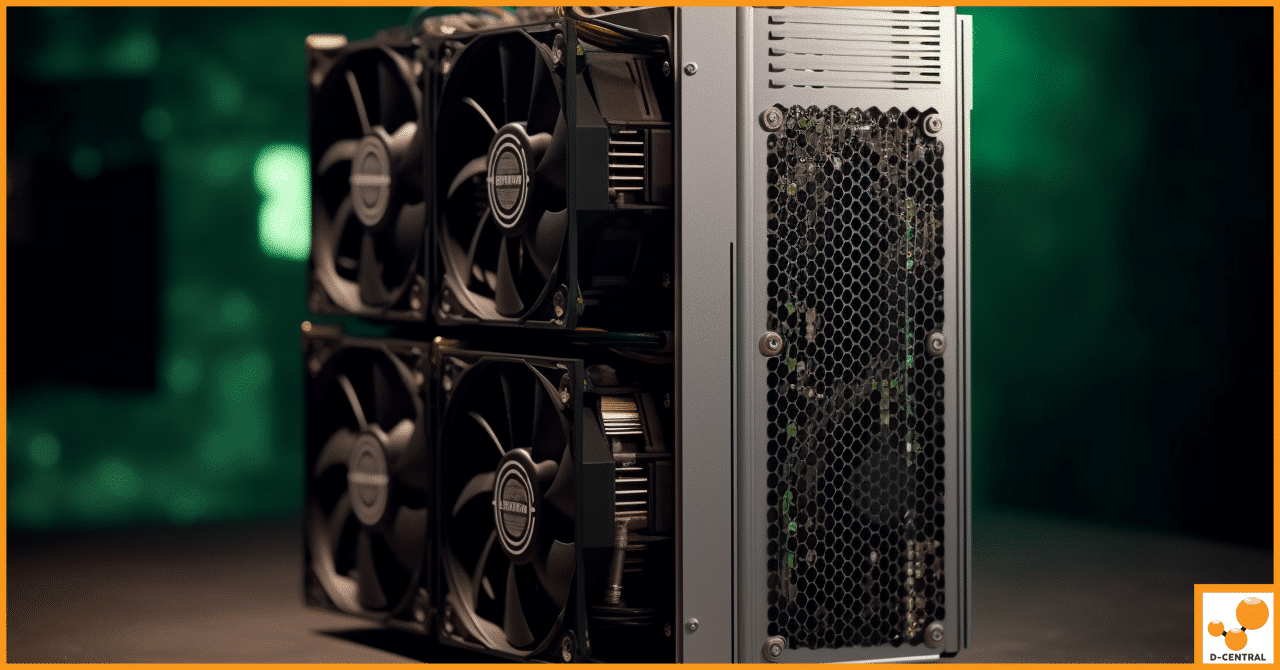
The Antminer S9: Unveiling the Secrets to its Continued Success in the Bitcoin Mining Industry
If you are familiar with the cryptocurrency mining industry, chances are you’ve heard about the Antminer S9. As one of
4479 Desserte Nord Autoroute 440, Laval, QC H7P 6E2
ASIC miners, or Application-Specific Integrated Circuits miners, are purpose-built devices for efficiently mining cryptocurrencies. Unlike versatile CPUs and GPUs, ASIC miners excel in processing specific crypto-related tasks, ensuring higher speed and efficiency. This guide will explain what is an ASIC miner, how they work, and their role in the cryptocurrency mining industry.
ASIC miners, or Application-Specific Integrated Circuits, are specialized hardware designed explicitly for the purpose of cryptocurrency mining. Unlike general-purpose hardware such as CPUs or GPUs, ASIC miner rigs are built to generate hashes efficiently, focusing on specific integrated circuit asic algorithms required for mining particular cryptocurrencies. This specialization allows them to perform mining tasks at speeds and efficiencies unattainable by more general-purpose hardware.
Each ASIC miner is optimized for one particular coin based on its unique hashing algorithm, resulting in enhanced mining efficiency. For instance, Bitcoin ASIC miners utilize the SHA-256 hashing algorithm, which is critical for Bitcoin mining. This optimization means that ASIC miners can solve cryptographic puzzles required for transaction validation more effectively than other types of hardware.
The introduction of ASIC miners in 2012 marked a significant shift in the competitive dynamics of Bitcoin mining. Their ability to handle the substantial computational power needed for solving cryptographic puzzles pushed out less efficient general-purpose hardware, making ASIC miners the go-to choice for serious miners. This evolution has driven many miners to adopt ASIC miners to remain competitive and maximize their mining rewards.
The journey of cryptocurrency mining hardware began with the humble CPU. Initially, Bitcoin mining could be done with a standard CPU from personal computers. This made it accessible for many individuals. However, as more people started mining, the difficulty of the mining process increased, making CPUs less efficient. The first miner to utilize more advanced hardware marked a significant shift in the landscape of mining.
The introduction of Graphics Processing Units (GPUs) in October 2010 marked a significant shift in mining efficiency. GPUs, originally designed for rendering graphics in video games, proved to be much more efficient at processing the parallel computations required for mining. This leap in efficiency made GPU mining the preferred method for many miners.
As mining difficulty increased, the evolution of mining hardware progressed as follows:
ASIC miners are marvels of modern engineering, composed of several critical components that work together to achieve optimal mining performance. These components include:
Power supply unit ensure a stable power flow, while sophisticated cooling systems prevent overheating, ensuring continuous operation.
Hashing algorithms are the backbone of cryptocurrency mining, and ASIC miners are primarily built to execute a limited number of these algorithms for optimal performance. For instance, Bitcoin ASIC miners utilize the SHA-256 hashing algorithm, which converts input data into a long hexadecimal number. The goal of hashing in mining is to reach a number less than the target hash, a task that requires immense computational power.
The most powerful Bitcoin ASIC miners can achieve hashing power exceeding 400 terahashes per second, showcasing their capability to process vast amounts of computing power quickly. This incredible performance is what makes ASIC miners so effective and sought after in the world of cryptocurrency mining.
Cooling systems are vital for the efficient operation of a cooling system ASIC miners. These systems prevent overheating, which can damage the hardware and reduce mining efficiency. Various cooling methods, such as liquid cooling and submersion in non-conductive oil, have been developed to manage the heat generated by these powerful devices.
As the demands on ASIC miners grow, adequate cooling solutions are becoming increasingly sophisticated, addressing the heat-intensive requirements of modern data centers. Effective cooling not only prolongs the lifespan of the miners but also ensures they operate at peak performance.
Mining pools play a crucial role in the world of cryptocurrency mining. Mining pools boost the chances of earning block rewards by pooling the hashing power of multiple miners. This collective approach allows miners to achieve more consistent payouts compared to solo mining, where the probability of solving a block is much lower.
When miners join a mining pool, they contribute their computational power to the pool’s efforts, sharing in the rewards based on their contribution and adhering to the payment rules. This system ensures that even individual miners with less powerful hardware can still participate and earn rewards, making the mining process more inclusive and accessible.
ASIC miners offer several key advantages for cryptocurrency mining:
These key factors make ASIC miners a preferred choice for serious miners.
Compared to other mining techniques, ASIC miners generally perform better, enhancing potential higher mining rewards.
ASIC miners are specifically designed to compute complex mathematical algorithms at speeds that outperform traditional mining hardware. The evolution from CPUs and GPUs to ASIC devices has significantly increased mining speed and efficiency. ASIC miners excel at generating cryptographic hashes efficiently due to their specialization in specific algorithms, leading to lower power consumption and higher output.
This high efficiency allows miners to earn rewards faster and more reliably, making ASIC miners a valuable investment. Innovations in ASIC technology continue to propel the mining industry forward, enhancing both efficiency and performance metrics.
Utilizing ASIC miners can significantly reduce electricity costs associated with mining, thereby increasing overall profitability. Their high efficiency and optimized power consumption mean that miners can achieve higher returns on their investment, making ASIC miners a financially sound choice for those looking to maximize their mining rewards.
ASIC miners are designed with durability in mind, ensuring they can withstand the rigors of continuous operation. Their robust construction reduces the risk of failure, providing a reliable solution for ongoing mining operations. Many ASIC miners are built to last several years, with a typical lifespan ranging from five to seven years under optimal usage and maintenance conditions, offering a long-term solution for cryptocurrency mining.
Prioritize models known for their durability and long-term reliability when selecting an ASIC miner. This ensures that the initial investment in the hardware will pay off over time, providing consistent performance and reducing the need for frequent replacements.
ASIC miners provide considerable benefits. However, they also have some disadvantages. One of the primary challenges is their high cost, which can pose financial hurdles for many potential users. ASIC miners require substantial initial investments, often costing thousands of dollars depending on the model. Additionally, ASIC miners are inflexible; once they are designed for a specific hashing algorithm, their functionality cannot be altered.
This inflexibility means that if there are changes in mining algorithms, ASIC miners may become obsolete, leaving miners with hardware that can no longer be used for its intended purpose. Furthermore, ASIC miners lack resale value since they are specialized for mining a specific cryptocurrency, making them less versatile compared to other types of mining hardware. ASIC miners are specifically designed to solve specific algorithms for specific cryptocurrencies, further limiting their adaptability.
Selecting the right ASIC miner requires careful consideration of several factors. The recommended minimum hash rate for an ASIC miner is 130 TH/s as of December 2024, indicating its capability to process cryptographic calculations efficiently.
Other factors to consider include energy consumption efficiency, the manufacturer’s reputation for support, and the initial cost of the miner.
A miner’s hash rate, expressed in terahashes per second (TH/s), is a critical factor in determining its efficiency and profitability. The hash rate indicates how quickly the miner can perform the cryptographic calculations necessary for mining. A higher hash rate generally means that the miner can solve more cryptographic puzzles in a given time, increasing the chances of earning mining rewards.
When choosing an ASIC miner, it’s essential to select a model with a hash rate that aligns with your mining goals and the current difficulty of the cryptocurrency network.
Energy efficiency is a key factor that significantly affects the profitability of cryptocurrency mining. High power consumption can lead to exorbitant electricity costs, which can eat into mining profits. Therefore, it’s crucial to choose an ASIC miner that offers high power efficiency. Energy efficiency is measured by how much electricity a miner uses compared to the performance or hash rate it delivers, efficiency compared to other miners is also important. For example, the Bitcoin Miner S21 XP Hyd. offers 12 J/TH, illustrating the performance efficiency measure.
ASIC miners generally consume far less power compared to GPUs and CPUs, making them a more cost-effective option for large-scale mining operations. Efficient miners enable scaling operations without significant increases in energy consumption, thereby improving overall profitability and sustainability in crypto mining.
The initial purchase price of an ASIC miner is often higher compared to other types of mining hardware, but this upfront cost should be evaluated against potential long-term earnings and operational costs. Initial costs for ASIC miners are typically higher than for GPUs or CPUs, which can deter individual miners from entering the market. Evaluating the profitability of an ASIC miner involves considering the high cost of the hardware, potential electricity costs, and the anticipated mining rewards. A steep upfront investment can be a deterrent for small-scale miners, making it essential to carefully assess the cost-to-reward ratio.
Before investing in an ASIC mining rig, various investment factors must be considered to ensure a wise financial decision. Miners should evaluate the potential long-term profitability of the hardware, factoring in the risks and challenges associated with cryptocurrency mining, such as changes in mining difficulty and cryptocurrency prices, especially when it comes to mining rigs.
Setting up your ASIC miner involves several crucial steps to ensure a smooth and efficient mining operation:
This initial planning phase is essential to understand the potential returns and the resources required for successful mined mining.
Next, follow these steps for setting up your mining software: 1. Choose and install popular mining software options such as MultiMiner, CGMiner, or BitMiner. 2. Configure the miner’s settings according to the manufacturer’s specifications to optimize performance. 3. Choosing the right mining software is crucial for connecting the mining hardware to the network or pool. 4. After installing the mining software, join a mining pool to increase your chances of earning rewards with a computer program.
Mining pools combine the hashing power of multiple miners, providing more consistent payouts compared to solo mining and participating in a bitcoin mining pool.
Avoid common mistakes to ensure your ASIC mining setup operates smoothly. Regular maintenance, proper cooling, and monitoring of the miner’s performance are essential to keep your mining operation running efficiently. Following these steps will help you maximize the potential of your ASIC miner and achieve successful cryptocurrency mining.
Cryptocurrency price fluctuations significantly affect profitability of ASIC mining operations. When cryptocurrency prices are unstable, it directly affects miners’ earnings, highlighting the risks associated with mining. Higher mining difficulty reduces the likelihood of mining rewards, further complicating profitability. Price volatility can lead to periods of high profitability, but it can also result in substantial losses, making it a double-edged sword for miners.
During volatile periods, there may be opportunities for higher returns, but miners must be prepared for the possibility of price drops that could make mining unprofitable. Several factors influence mining profitability, including power expenses, cryptocurrency costs, and network difficulty, all of which need to be considered when planning a mining operation.
ASIC mining and GPU mining each have their own advantages and disadvantages. ASIC miners are purpose-built for cryptocurrency mining, designed to achieve superior hash rates compared to GPUs and CPUs. Their advantages include:
These features make ASIC miners the preferred choice for serious miners.
On the other hand, GPU mining offers greater flexibility as it can mine various cryptocurrencies, allowing miners to adapt to changes in the market. The choice between ASIC and GPU mining often hinges on the miner’s specific goals and the dynamics of the cryptocurrency market. While ASIC miners provide unmatched efficiency for specific tasks, GPU miners offer the versatility needed to switch between different cryptocurrencies based on profitability.
Recent advancements in ASIC technology are transforming the cryptocurrency mining landscape by enhancing efficiency and performance. Innovations in power consumption and processing speed are critical for maximizing mining profitability. These improvements allow miners to achieve higher hash rates with lower energy consumption, making mining operations more sustainable and cost-effective.
The continuous evolution of ASIC technology is expected to drive further sustainability and efficiency in the cryptocurrency industry, shaping its future market dynamics. As ASIC technology advances, miners can look forward to more powerful and energy-efficient devices, ensuring that cryptocurrency mining remains a viable and profitable endeavor in the realm of digital currency.
High energy consumption and ecological impact are significant environmental concerns associated with ASIC mining. Non-renewable energy sources like coal or natural gas contribute to the environmental degradation caused by large-scale mining operations. Bitcoin mining alone consumes between 110 to 140 terawatt-hours annually, highlighting the immense scale of energy consumption.
The environmental footprint of mining varies greatly depending on the energy sources used. Renewable energy sources, such as hydroelectric and geothermal power, lead to lower emissions compared to fossil fuels. In Iceland, for example, nearly all cryptocurrency mining operations utilize renewable sources, predominantly hydroelectric and geothermal energy, which enhances the overall mining power efficiency.
Some mining operations have started using stranded energy resources, such as excess natural gas, to power their activities in response to environmental concerns. D-Central’s Bitcoin Space Heater Editions utilize waste heat generation from mining to provide home heating, effectively merging energy efficiency with cryptocurrency mining. These innovative solutions help reduce the environmental impact of mining while promoting energy-efficient practices.
D-Central Technologies is at the forefront of innovation in the ASIC mining industry. With over a decade of industry experience, D-Central specializes in local manufacturing, expert refurbishing, and precision tuning of ASIC hardware, ensuring the longevity and efficiency of their products. As Canada’s premier source for ASIC miners, D-Central offers a range of solutions tailored to both large-scale farms and DIY home miners.
D-Central Technologies is recognized as a leading ASIC repair center in Canada, focusing on optimizing Bitcoin heating options. Their Bitcoin Space Heater Editions turn mining into a dual-purpose energy efficiency tool, providing home heating while mining cryptocurrencies. This innovative approach addresses both the practical and environmental challenges of cryptocurrency mining.
Partnering with innovators like CryptoCloaks, D-Central aims to make mining smarter, cleaner, and more accessible. Their cutting-edge 3D printing farm further enhances their ability to deliver customized solutions, ensuring that miners have access to the latest technological advancements. With a focus on sustainability and efficiency, D-Central Technologies continues to lead the way in the cryptocurrency mining industry.
In summary, ASIC miners have revolutionized the cryptocurrency mining landscape, offering unmatched efficiency and performance. From their specialized design to their ability to handle the immense computational power required for mining, ASIC miners are the go-to choice for serious miners looking to maximize their rewards. Understanding the evolution of mining hardware, how ASIC miners work, and the factors to consider when choosing and setting up an ASIC miner is crucial for achieving success in the mining industry.
While ASIC miners offer significant advantages, it’s essential to be aware of their drawbacks and the environmental impact of mining. Innovations in ASIC technology and efforts to use renewable energy sources are paving the way for a more sustainable future. D-Central Technologies stands at the forefront of these advancements, providing innovative solutions that make mining smarter, cleaner, and more accessible. With the right knowledge and tools, anyone can navigate the ever-evolving world of cryptocurrency mining and achieve their mining goals.
An ASIC miner is a specialized device tailored for cryptocurrency mining, designed to offer high efficiency and performance for specific hashing algorithms. This makes it a powerful tool for those serious about mining.
ASIC miners are specifically designed for certain cryptocurrencies, delivering superior efficiency and hash rates, whereas GPU miners are more versatile and can mine various cryptocurrencies. This specialization makes ASICs more powerful for specific tasks.
The main benefits of using ASIC miners are their higher efficiency, increased profitability, and durability, which make them a reliable choice for long-term mining operations. These advantages can significantly enhance your mining success.
The environmental concerns related to ASIC mining primarily involve high energy consumption and the reliance on non-renewable energy sources, which lead to ecological degradation. It is essential to address these impacts to foster sustainable mining practices.
D-Central Technologies can enhance your ASIC mining operations by providing manufacturing, refurbishing, and optimization services, as well as innovative solutions like the Bitcoin Space Heater Editions to improve energy efficiency and performance.
DISCLAIMER: D-Central Technologies and its associated content, including this blog, do not serve as financial advisors or official investment advisors. The insights and opinions shared here or by any guests featured in our content are provided purely for informational and educational purposes. Such communications should not be interpreted as financial, investment, legal, tax, or any form of specific advice. We are committed to advancing the knowledge and understanding of Bitcoin and its potential impact on society. However, we urge our community to proceed with caution and informed judgment in all related endeavors.
Related Posts

If you are familiar with the cryptocurrency mining industry, chances are you’ve heard about the Antminer S9. As one of

Dive into the world of Bitcoin lottery mining and learn how to calculate your chances of striking digital gold. This

In the world of digital finance, Bitcoin has emerged as a groundbreaking innovation. As the first decentralized cryptocurrency, it has